Lossy vs Lossless Compression: Comprehensive Analysis
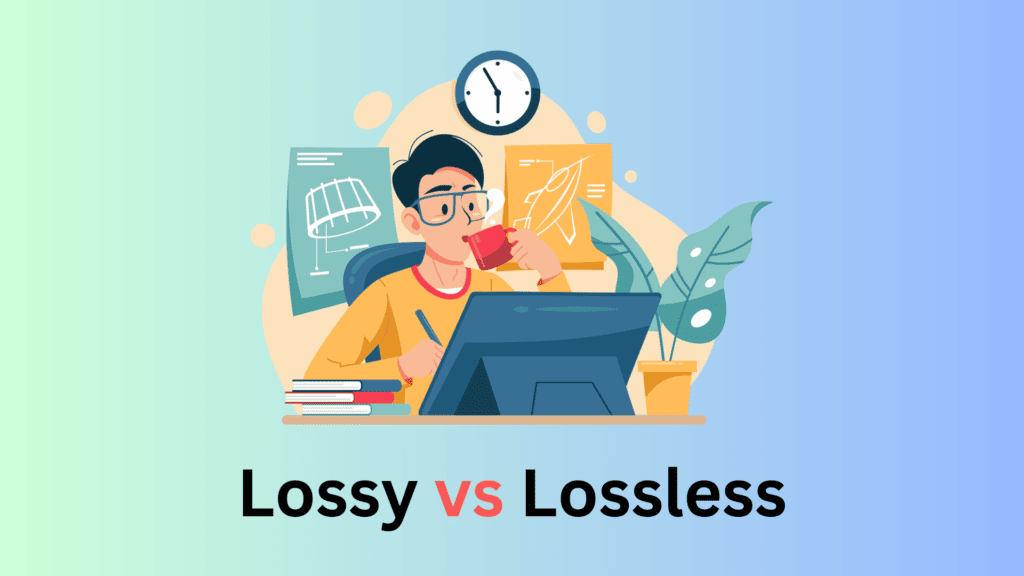
Data compression is like packing for a trip.
When we pack, we fit as much as possible into a small space and carry everything necessary.
Lossy and Lossless compression are two ways to do this.
But which one should you pick in a lossy vs. lossless compression format battle?
Lossy compression is like rolling your clothes in the backpack to save space. It reduces the size but ruins the ironed clothes.
On the other hand, lossless compression is like carrying a travel bag. It keeps everything without losing any detail. But it’s too heavy to carry.
Now, most users, including you, are torn between saving quality and money.
In this article, we’ll study these two methods, test them, and see what kinds of files they work best with and how you can use them in real life.
What Is Lossy Compression?
Lossy compression is a data encoding method that reduces file size by removing non-essential details. Lossy image compression permanently removes the less essential data.
Lossy compression is the most effective way to manage digital images. It’s especially true for web use, which can reduce file sizes by up to 90% while maintaining a high-quality appearance.
How Does Lossy Image Compression Work?
Lossy image compression requires careful data reduction and quality maintenance. Let’s try to understand how this technical process works in simple terms:
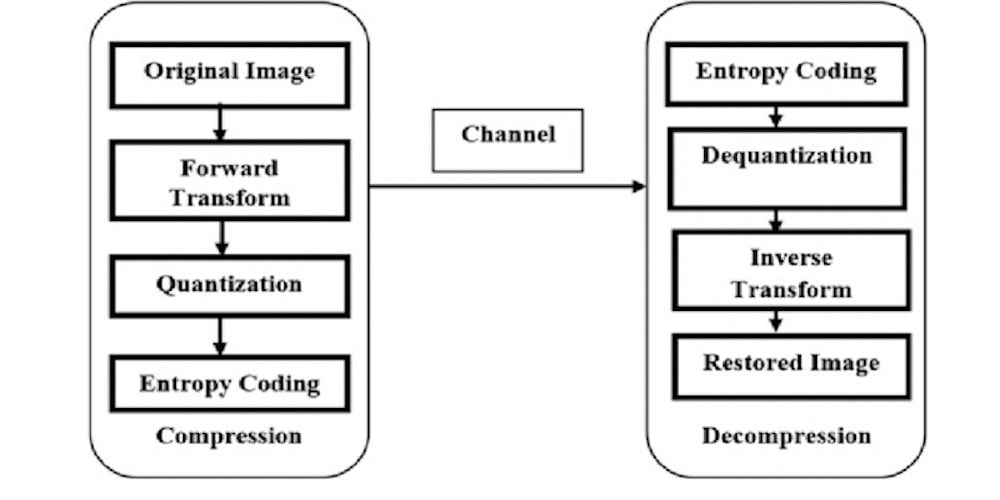
Step 1: Initially, the lossy algorithm scans the image for expendable data, focusing on color variations you cannot see with the naked eye. Then, the quantization process groups similar values to simplify the data.
Step 2: The next step encodes the simplified data, using algorithms such as DCT to eliminate data redundancies. Techniques such as the YCbCr color space transformation and DCT represent the image data efficiently.
Step 3: The final compressed image is much smaller, but it still has a good enough quality for most uses, especially for web graphics and digital media.
Remember, lossy image compression data is irreversible, and over-compression can lead to noticeable quality loss. It’s beneficial when storage and bandwidth efficiency trump the need for perfect image fidelity.
Lossy Compression Algorithms
A few compression algorithms can perform lossy compression. Let’s learn about a few of them:
Discrete Cosine Transform (DCT): It’s most commonly used in JPEG compression. It converts image data into frequency components and dumps the less significant ones to reduce size.
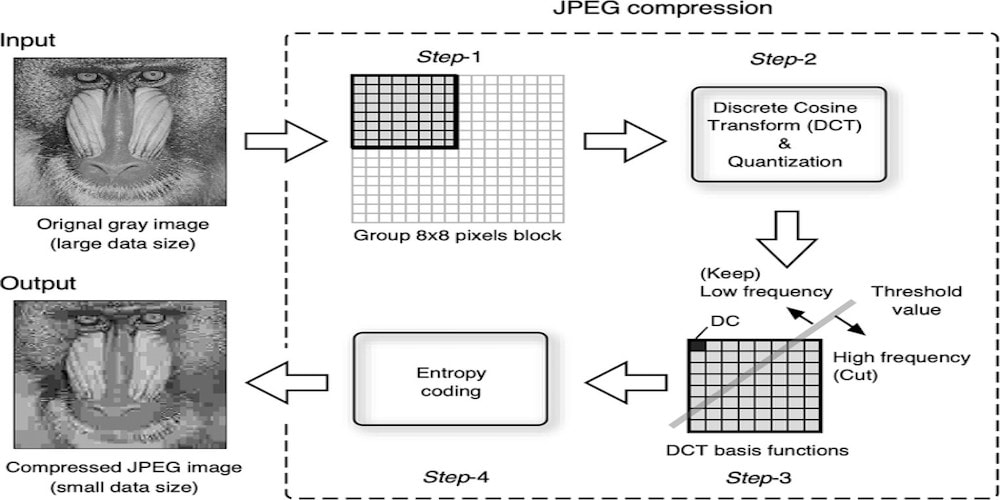
Transform Coding: Transform coding measures and transforms consecutive samples from a source input via blocks (containing all pixels in a frame).
Fractal Image Compression: Uses self-similar patterns (fractals) in images to reduce their size by finding and encoding these patterns that show up repeatedly.
Chroma Subsampling: Chroma subsampling reduces color resolution for videos and JPEG images because human eyes are less sensitive to color than luminance.
Lossy Compression File Types
Here are some of the best lossy compression file formats to use on your projects:
JPEG: Ideal for colorful photos, supports millions of colors, and has adjustable compression. JPEG balances image quality and file size for websites, social media, and email.
WebP: This Google-developed web image outperforms PNG and JPEG in transparency and animation. It’s built to speed up web image loading and compress images while maintaining visual quality.
MP3: It revolutionized music streaming and storage by compressing audio without losing quality. Reduces file sizes by removing audio frequencies less perceivable to human ears. Offers various bitrates to balance quality and size.
MP4: The versatile MP4 format supports video, audio, and image, making it popular for online streaming, editing, and distribution. Its compatibility, quality, and size make it a multimedia standard.
HEIC (High-Efficiency Image Format): Used in newer Apple devices, it provides high-quality images at small file sizes for modern photography storage. It supports advanced features such as live photos and depth maps.
TIFF (Tagged Image File Format): Although TIFF is known for lossless compression, its lossy variant is helpful in graphics and publishing for complex layers and pages. It can store multiple layers and pages for detailed image editing.
Pros and Cons of Lossy Compression
Let’s look at some of the key benefits and drawbacks of lossy compression:
Pros of Lossy Compression:
- Size Reduction: Lossy compression techniques effectively reduce image file sizes and improve storage space efficiency.
- Bandwidth Efficiency: Lossy compression reduces file sizes and bandwidth usage, making it ideal for web browsing when bandwidth is limited.
- Faster loading: Faster page loads and better user experience result from smaller image sizes.
- Versatile use case: Lossy compression is suitable for photos, videos, and audio files where minor quality loss is acceptable.
- Custom compression: You can select the compression level, balancing file size and image quality based on your requirements.
- Supports many formats: Supports popular image formats such as JPEG, which is widely used on various platforms.
Cons of Lossy Compression:
- Quality loss: Lossy compression can reduce image quality and cause objects, especially at high compression ratios. It gets worse when you edit lossy compressed images.
- Permanent data loss: If you compress an image with lossy compression, you can’t regain the lost data. It’s gone permanently.
- Less professional: Lossy compression may not meet the high fidelity standards of graphic designers, artists, and photographers due to image quality compromises.
What Is Lossless Compression?
Lossless compression is a compression method that makes files smaller without losing data. It perfectly reconstructs the original data from the compressed data.
When you need things like medical pictures or technical drawings, to be exact, lossless compression is essential because it keeps all the original details.
How Does Lossless Compression Work?

Lossless compression removes statistical duplicate image elements from image files and makes new smaller ones. Keeping the core elements preserves image quality.
Let’s learn how lossless compression works:
Step 1: The lossless compression program initially looks through the data to find patterns and repeated parts. It scans for the recurring elements or sequences to identify and remove.
Step 2: After it finds these patterns, the program uses data compression methods like Huffman or Lempel-Ziv-Welch. It gives common data elements shortcodes and rare elements longer codes. It makes the data smaller but still keeps all the quality.
Step 3: Lossless compression can restore the original data from the compressed files. It’s possible because of the reversible file making process. When you expand it again, the file contains everything needed to restore the original data.
Lossless Compression Algorithms
There are a few compression algorithms that can achieve lossless compression. Let’s learn about a few of them here:
Huffman Coding: The Huffman Coding compression algorithm reduces the size of files by using shorter codes for frequently occurring data elements. It’s widely used in ZIP file formats and for text compression.
Lempel-Ziv-Welch (LZW): The LZW compression algorithm is widely used in GIF and TIFF formats due to its simplicity and effectiveness. It saves space by using single codes instead of longer strings of characters.
Run-Length Encoding (RLE): The RLE algorithm uses counts and values instead of long sequences of repeated elements to save space while compressing. It’s used in bitmap images.
Deflate: Deflate is a mix of LZ77 and Huffman coding. It’s used in PNG and ZIP formats because it is fast and good at compressing files.
Lossless Compression File Types
Here are some of the best lossless compression file types to use for your projects:
PNG: The widely used image format employs lossless compression, making it ideal for logos, icons, and high-quality website graphics. PNG supports transparency and quality in images with text and sharp edges.
BMP (Bitmap Image File): BMP is an ideal image format for high-resolution graphics with sufficient detail. You can use BMP image files for digital art and professional design because they compress images without losing quality.
RAW (Raw Image Formats): Professional photographers prefer RAW to capture all sensor data for post-processing flexibility. Save photos in RAW format. It preserves image data without quality loss, making it ideal for archiving.
GIF (Graphics Interchange Format): You can use GIF images to create short animations and memes online. Thanks to their support for multiple frames in a single file. GIF works well for website buttons and banners due to its small file size and losslessness.
Pros and Cons of Lossless Compression
Let’s look at some of the top benefits and drawbacks of lossless compression:
Pros of Lossless Compression:
- Original Quality: Lossless compression ensures no quality loss and maintains the original standard of image files.
- Reversible: You can perfectly reconstruct the original file from the compressed file, making it ideal for archiving.
- High-quality image: Ideal for high-quality audio and visuals, such as professional photography or printing, where image accuracy is critical.
- Editing flexibility: You can edit lossless compressed images without sacrificing overall quality.
- Supported formats: It supports popular image formats like PNG and GIF for images and FLAC for audio, which are widely accepted and easy to work with.
Cons of Lossless Compression:
- Larger file sizes: Lossless compression results in larger file sizes than lossy compression. It impacts storage and bandwidth.
- Not web-friendly: Lossless image files can slow down website loading times due to their larger sizes, which affects user experience and SEO.
- Limited compression: Less compression than lossy methods limits its ability to reduce file sizes.
Lossy vs Lossless Compression: 7 Core Differences
Let’s look at the key differences between lossy and lossless image compression methods:
Data Integrity
Post-compression data integrity is one of the most important factors you need to consider when comparing lossy and lossless compression. Let’s compare lossy vs lossless compression data integrity:
Lossy Compression
Lossy compression reduces your data integrity. It permanently removes some original data from an image or audio file.
It’s a trade-off for significantly reducing the file size. So, when you use Lossy compression, particularly for images or music, it removes some of the less visible details to the human eye.
Also, you can’t restore the image files to their original state after compressing them in a lossy format. Besides, the quality will gradually degrade if you edit the lossy files several times.
Lossless Compression
Lossless compression keeps your data integrity. It reduces file size without sacrificing any data.
So, compressing and then decompressing in a lossless format won’t alter your data. You can restore every bit of the original data.
Moreover, unlike the lossy compressions, the quality will remain the same if you edit a lossless image file multiple times.
Clearly, the Lossless compression method keeps your data integrity, whereas lossy compression reduces it.
File Size Reduction
Lossy and lossless compression methods can significantly alter file sizes. Now, you need to consider your applications for the image files and decide whether you want massive file size reduction.
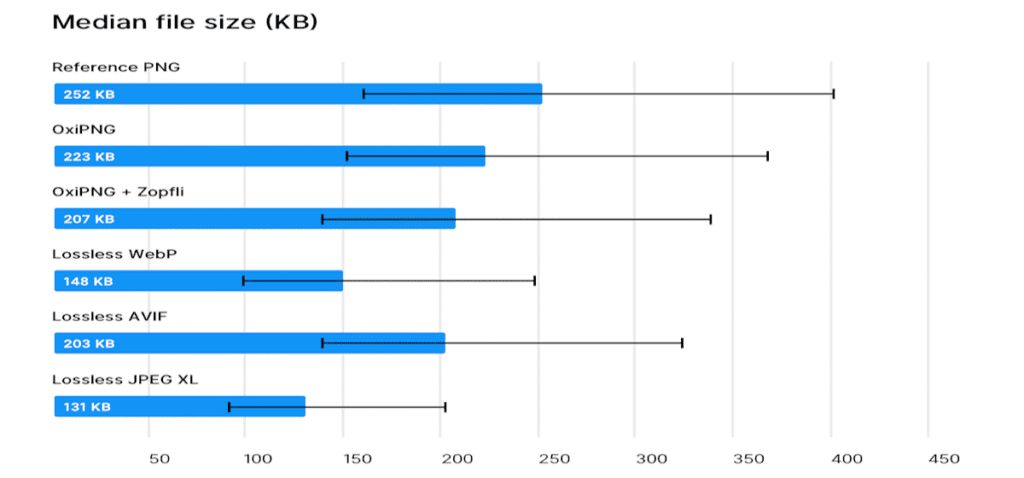
Let’s learn how the file size reduction works for lossy vs lossless compression methods:
Lossy Compression
The lossy compression format allows you to reduce image data significantly. That means significant file size reduction.
For example, you can compress a JPEG image by up to 90% and files to 5-10% of their original size while maintaining image quality for general use. That’s a massive reduction of file size!
This massive reduction makes lossy compression ideal for your web applications, where smaller file sizes result in faster loading times and more efficient storage.
Lossless Compression
On the other hand, the lossless compression method prefers to keep file sizes relatively high. It mainly focuses on the compressed file’s quality rather than the size reduction.
Usually, you can compress image formats such as PNG and FLAC for audio to 50-60% of their original size using lossless compression methods. But you can go up to 90% using the Lossy compression.
Although lossless compression reduces less data and less image size than lossy compression, it’s necessary to archive data and high-quality media production.
Quality of Output Data
The output quality after compression significantly varies between lossy and lossless methods. Understanding this can help you choose the best method for your needs.
Lossy Compression
With lossy compression, you are giving up on quality to save space. You get a smaller file size, but the image quality decreases. For instance, lossy compression JPEG images may get a little blurry, and some colors may alter.
You may not be able to detect the quality of differences with your open eyes. But somehow, you may feel it.
Lossless Compression
On the other hand, lossless compression in PNG, RAW, WAV, and FLAC data files preserves the original quality after compression. So you can’t tell any difference in quality.
Lossless compression is ideal for you if you are into professional photography, digital art, and high-fidelity audio recordings that require data accuracy. However, file size reductions are less dramatic than lossy compression, which may affect storage and bandwidth efficiency.
Compression Ratios
Compression ratios show how well each compressing method reduces your file sizes. Let’s compare their compression ratios here:
Lossy Compression
Lossy compression can significantly reduce file sizes by more than 50% to up to 90%. For example, you can compress JPEG images to 10% of their original sizes for general use without losing noticeable loss in image quality.
Lossy compression test using the Shortpixel Image Compressor:
We chose an image and processed it using the Shortpixel image compressor.
Original Image Size: 1.18 MB
Post lossy compression image size: 199 KB
Reduction of size: 83.51%
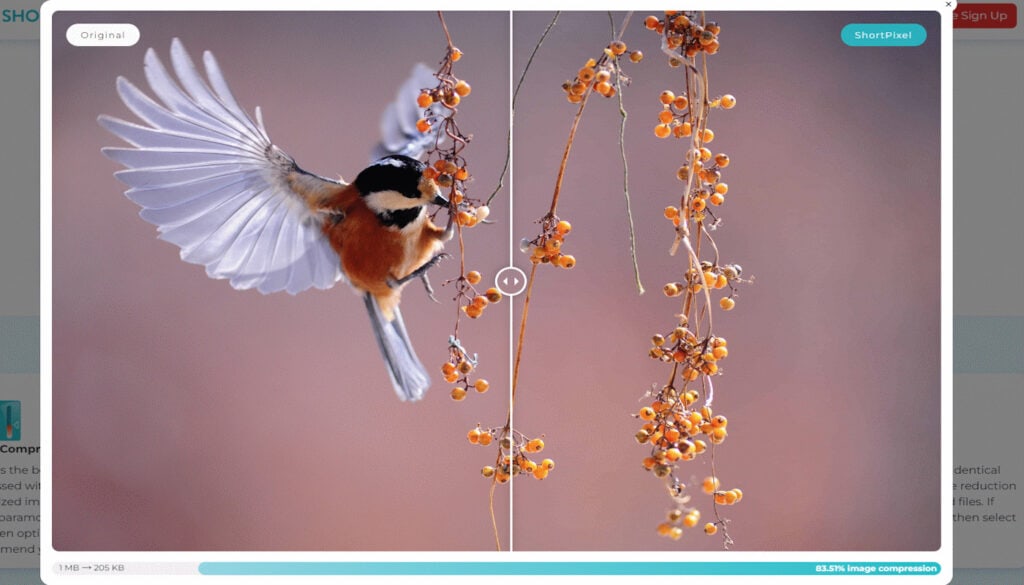
Here, you’ll notice that the background color of the compressed side of the image appears slightly different than the uncompressed side.
You’ll only notice this if you’re zooming in or printing the image. Otherwise, enjoy the 83.51% compression that will save you storage space.
Lossless Compression
In contrast, lossless compression reduces file size while preserving data fidelity. For example, lossless compression may reduce a PNG image to 30-40% of its original size.
Here, we ran the same image through the Shortpixel lossless compressor:
Lossless compression test using the Shortpixel Image Compressor:
Original Image Size: 1.18 MB
Post lossless compression image size: 1.10 MB
Reduction of size: 9.26%
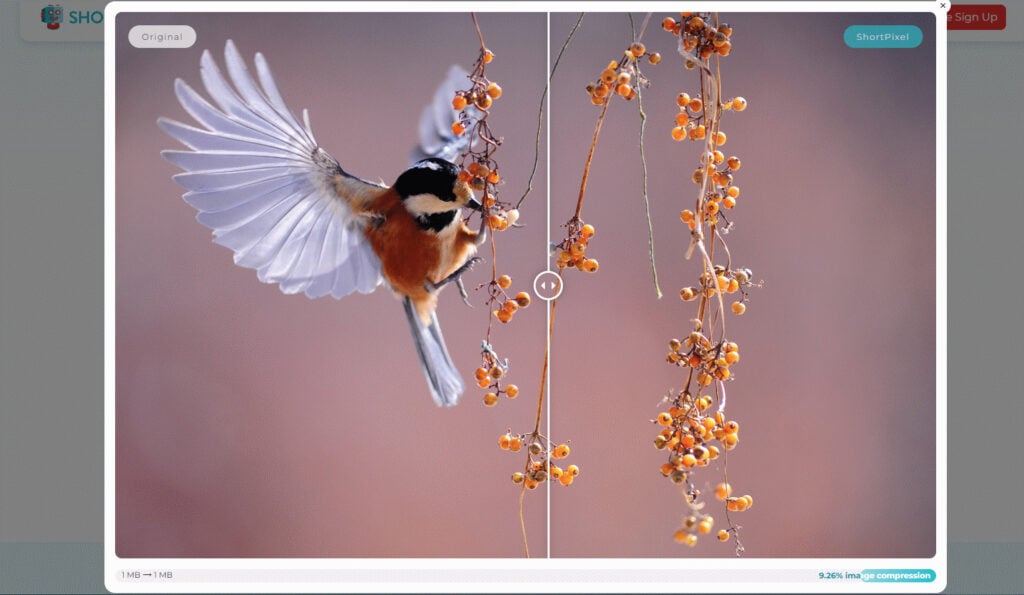
Here, you can see that the Shortpixel only compressed the photo by about 10% to maintain its authenticity and quality. It could go up to 30% or 40%, but 10% is ideal for preserving image quality.
Lossless compression carefully encodes all data to ensure complete restoration upon decompression. It’s a crucial factor for applications where every detail counts.
Data Recovery
You may occasionally need to decompress the files and return to the original files. Lossy and lossless compression methods function differently when it comes to data recovery.
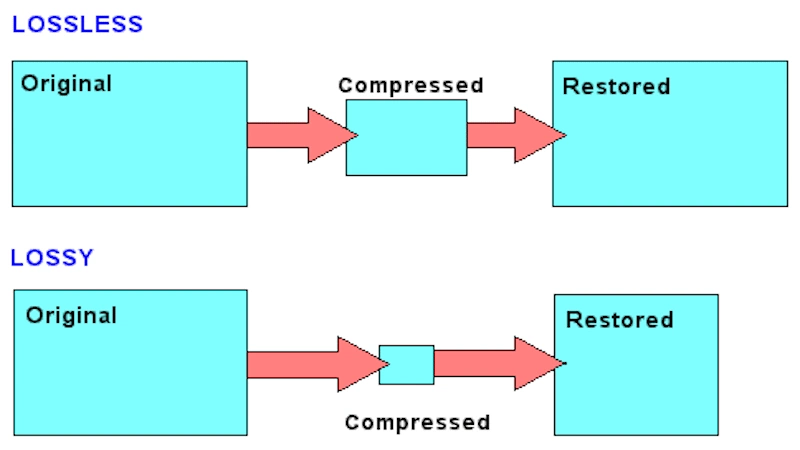
Lossy Compression
You can restore image data to its original state after lossy compression. It’s a one-way road; once you are in, there’s no way back. Lossy compression cannot restore quality or details.
If you compress a JPEG image and reduce its file size to 90% using lossy compression, you can’t get it back to the exact resolution and quality, reversing the compressing method. It’s just gone!
Lossless Compression
On the other hand, lossless compression allows you to recover all original data after decompression. It only reduced the unnecessary elements of the image data file.
This feature is crucial in PNG and RAW files, where every data element matters. Unlike lossy compression, lossless compression lets you decompress an image without losing quality or information.
Efficiency
Lossy Compression
Lossy compression is highly efficient in reducing file sizes. You can compress a JPEG image to its fraction to its original size to make it quick to upload and download.
This efficiency comes at the cost of quality. However, many web applications and websites would accept this loss to get the flexibility.
You can reduce a 10 MB high-resolution image to under 1 MB without losing quality, ensuring standard visibility. Yet, a 90% reduction in size would result in extreme efficiency.
Lossless Compression
Lossless compression is more efficient when you prioritize data integrity over the file size. You can compress a PNG image to about 10-30% smaller than its original size. But it will keep all its quality.
While the file size is larger than the file size with lossy compression, you can be confident that the image has preserved every pixel. It’s essential for archival purposes, where you may need to edit or print in the future.
Best Uses
Understanding when to use lossy vs lossless compression is the foundation of your overall compression success. Knowing their best uses helps you choose lossy and lossless compression:
Lossy Compression
Lossy compression is helpful for web graphics, streaming media, and social media sharing. It balances quality and efficiency by reducing file sizes for faster data transfer.
Many websites use JPEG, a lossy format that optimizes load times without sacrificing significant image quality.
Besides, both MP3 and MP4 use lossy compression methods. Their small file sizes and high quality make them ideal for streaming audio and video.
Lossless Compression
Conversely, photographers, designers, and medical imaging professionals should use lossless compression. It saves every pixel and sound wave for better detailing.
So, you need solid image types like RAW and PNG to deliver professional-grade images. Likewise, WAV and FLC formats are for high-grade audio quality.
When every detail matters, like archiving, backing up, or making high-end videos, lossless compression keeps your data safe over time.
Lossy vs Lossless Compression: Which Should You Use?
When deciding whether to use Lossy or Lossless compression, it’s crucial to understand the distinct advantages and appropriate scenarios for each.

Here’s a detailed and robust explanation to help you make an informed decision:
When to Use Lossy Compression?
Ideal for Web Use: Lossy compression reduces file sizes and is ideal for image-heavy websites like online stores and blogs. You can improve page load times, user experience, and SEO using lossy compression. Websites that load faster retain visitors, reduce bounce rates, and increase conversions.
Quality vs. Size Control: Lossy compression gives you some control over the balance of image quality and file size. You can use image optimization tools to choose your ideal compression level, enabling a balanced approach that doesn’t overly compromise your image quality.
Social Media and Online Sharing: Lossy compression is the best option for sharing images on social media or via email when quick upload and download times are more critical than perfect image quality.
When Space is a Priority: If saving disk or cloud storage space is more important than image quality, then lossy compression is the way to go. It’s beneficial for reducing image or file size when quality is a low priority.
When to Use Lossless Compression?
High-Quality Archiving and Portfolios: Lossless compression preserves the original high-resolution image quality for professional photographers, graphic designers, and artists who showcase their work online.
Medical and Technical Imaging: Lossless compression is necessary for industries that rely on precise images, like technical drawing and medical photo imaging. It ensures accurate analysis and diagnostics by preserving all details.
Professional Applications: Graphic designers, artists, and photographers use lossless compression to maintain their work. High-quality prints, publications, and digital displays require proper image quality to maintain effectiveness and aesthetic value.
Conclusion
Whatever compression format you choose will save you space or give you quality. That’s a win for picking up to compress.
But the tricky part was knowing when to save space and when to preserve quality. Now you know which is better than the most.
You use lossy when you need to save space. Use lossless when you need to keep every bit of quality.
Your choice depends on what’s more important for your task.